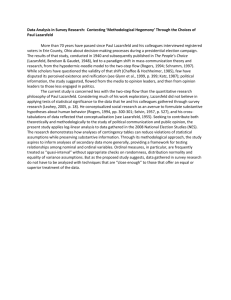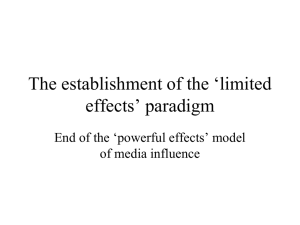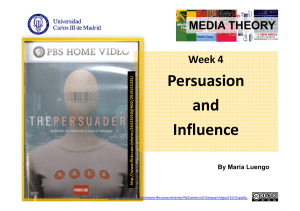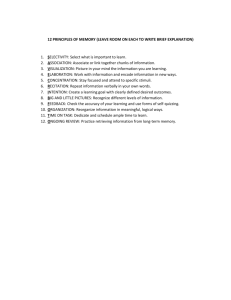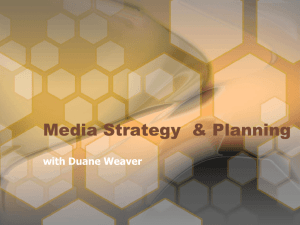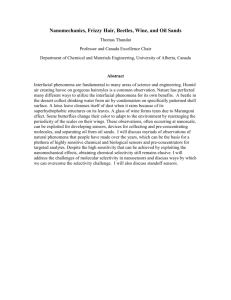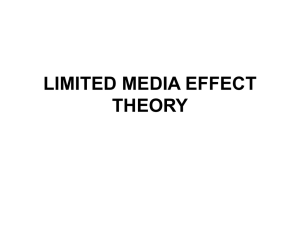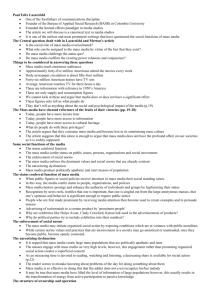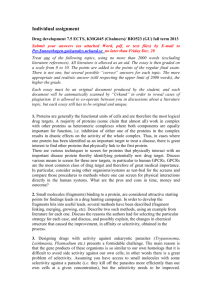limited effects model
advertisement
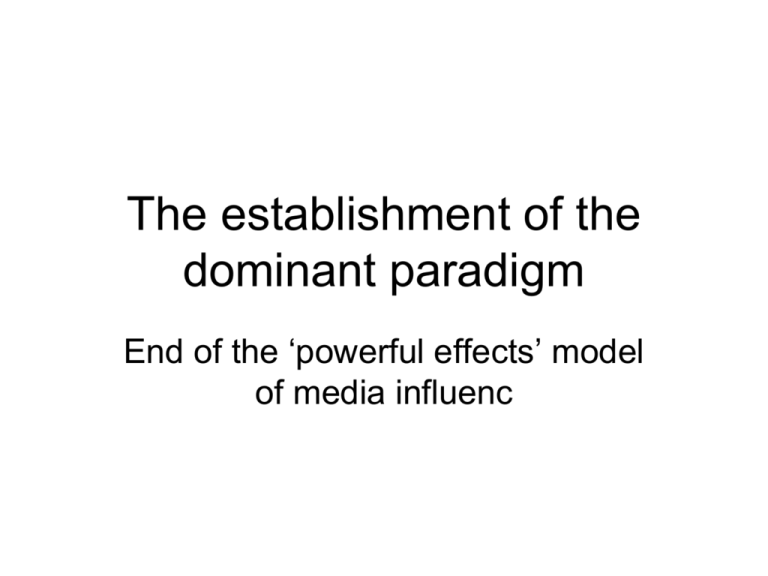
The establishment of the dominant paradigm End of the ‘powerful effects’ model of media influenc During the early 20th century, two major schools of thought • Chicago School – – – – – – liberal pluralist political orientation concern with the loss of community Need to create “Great Community” Organismic view of society Focus on the press Symbolic interactionism • Mass society theorists – – – – Fear of popular tyranny Vision of isolated, anomic society Focus on propaganda Freudian psychology Columbia School • Paul Felix Lazarsfeld emigrated from Austria to the U.S. in the 1930s. – A mathematician • Interested in the application of mathematics, especially the new statistics, to study of social problems – His main theoretic concern was how individuals make decisions Lazarsfeld • Set up research programs at Princeton (Radio Research Bureau) and at Columbia (Bureau of Applied Social Research) that combined study of practical problems with academic methods of research – Collaboration between academy and industry – Research team with multiple scholars/researchers each with special talents tackling a research area – Became a model for research efforts in the field • The earliest studies focused on audience size, reactions to and use of radio programming – As well as a wide array of social concerns that were not communication-oriented Features of the approach • Took the existing media system for granted (could not accommodate Theodor Adorno, a critical scholar brought to the school to add some critical theory to the approach) • Looked at society as a conglomeration of individuals • Interested in individual behavior/attitudes/ knowledge resulting from exposure to media messages/campaigns • Focus groups, interviews and surveys were the usual methods of study The People’s Choice • Lazarsfeld, Berelson, and Gaudet – went to the Rockefeller foundation, Roper agency (provided money and interviewing), Life magazine (had money) • Study of the1940 election in Erie County (Sandusky), Ohio – Franklin Delano Roosevelt v. Wendell Willkie Research Questions : • How do people decide to vote as they do? • What were the major influences on them? – "Social characteristics determine political preference." Erie County • Population 43,000 • mix of urban and rural voters--no really big cities, not many poor, minorities • Sandusky, the main city, and Ohio were both Republican • 1 strongly Republican newspaper, 1 neutral, 1 mildly and belatedly Democratic, Cleveland Plain Dealer endorsed Willkie • Radio stations came in from other places • National publications--Time, Life, Townsend farm journals • Stable politically • Relative lack of interest groups Timetable May June July August September October Republican Democratic Convention Convention Interview number 1 2 Total Main Poll Panel (3,000) (600) November Election 3 4 5 6 7 Main Panel (600) Main Panel (600) Main Panel (600) Main Panel (600) Main Panel (600) Control A (600) Control B (600) Group Control C (600) 1940 election • Result: country still overwhelmingly for Roosevelt, but less than in 1936 • Vote overwhelmingly by SES, religion • SES: Hi 71% GOP • Lo 35% GOP • Protestant 60% GOP • Catholic 23% GOP • Rural • Urban • Level of Interest in October strongly predictive of voting. • Lazarsfeld could predict with 76% accuracy which candidate the person would vote for by his/her demographics. That was better than the people themselves could predict. – Prediction is taken as criterion of validity of theory. – "Cross-Pressures" Interpersonal influence • Opinion Leaders 21% – ("Have you tried to influence someone on a political issue recently?"; "Has anyone asked your advice recently on a political issue?") – opinion leaders were thought to be a rather small group of influential people, although influence was not actually shown Changers • Whenever a person in the sample changed his/her vote intention, the interviewer asked why. • Democrats mentioned radio most often (30% vs. 20% for newspapers) • Republicans mentioned newspapers (31% vs. 17% for radio). • Magazines--Saturday Evening Post, Farm Journal before nominations • Slight difference in exposure to the media in the same direction as changers above. – Helpful – – Most Important – --66% newspaper --68% radio --38% radio --23% newspaper • Over half the voters rated media most important, 2/3 rated news media helpful • However, Lazarsfeld et al. identified a “Two-step flow” and concluded that interpersonal communication was most important Selective exposure • Those most likely to be predisposed to vote Democratic were exposed to more proDemocratic propaganda (with the analogous situation true for Republicans) • Lazarsfeld decided this indicated that those who were predisposed to vote one way or another chose to expose themselves to propaganda that was positive toward the party Cross-over voters • Criteria: 1) Had to vote for FDR in 1936 • 2) Had to vote for Willkie in 1940 • 3) Had to think Roosevelt had done a good job • 4) Had to delay their decision until after nominations • • Results: Found only 15 people who qualified – Only 9 recalled issue – Only 6 mentioned 3rd term issue (very stringent requirements to find issue importance) • Conclusion: Issues do not show much power in voter decision Time of decision • 1/2 made up their minds before May • Once they knew the nomination, another 1/4 made up their mind • 1/4 made up their mind between nomination and election • Columbia did another study in 1948, then got out of campaign studies Generalizability? • A particular presidential campaign – FDR and the Depression, Nazi rise in Germany – 1932 & 1936 Democratic victories (Republicans became tightly knit, ended factional fighting) – no strong Republican candidate (Wendell Willkie nominated by default) – FDR not nominated till late (August) because of unprecedented 3rd term (3rd term an issue) • Lazarsfeld was not looking at nonvoters • Lazarsfeld did not look at influences outside of the campaign • There has been a significant increase in formal education since that time • Political campaigns have become professionalized • Partisanship has declined • Television is now the main political information source • Movement of news toward entertainment Even so • The Columbia studies became the gospel of political campaign communication theory and research for the following 30 years • Campaign studies of this size declined significantly until the University of Michigan began their massive, longrunning series in the 1950s – Did not even study media influence in early years • (Chaffee and Hochheimer, 1982) • Assumptions of the model: 1. The act of voting is a consumer decision equivalent to the purchase of a product in the marketplace. 2. That politics and communication can be assessed in contrast to an idealized system, in which all people should be concerned, cognizant, rational, and accepting of the political system, and in which the institutions of communication should be comprehensive, accurate, and scrupulously fair and politically balanced. (Used sociological method of ideal types in the absence of comparative data). 3. That communication and politics are appropriately viewed from the top or power center rather than the bottom or periphery of the system. (media-centric and elite-centric rather than audiencecentric) 4. That the processes involved in political communication are approximately equivalent across time and space. (General theory) • Structure of data collection was individual, studying decision-making, although authors concluded that voting was primarily a group process. – "This led to a research agenda that looks at politics and voting as the sum of individual interactions with the media, "opinion leaders", and so forth, rather than the social networks through which information and influence flow." (Chaffee and Hochheimer, 1985). Thus, the study design was inappropriate for the study of the dynamics of political behavior. • "While the total effect is often large, the net effect is usually quite small." Katz and Lazarsfeld • Personal Influence: The Two-Step Flow of Communication • Katz and Lazarsfeld (1955) – based on ideas originating in the "People's Choice" • Concerned with the movement of information from media through interpersonal networks • Decatur study of opinion leaders conducted by the Bureau of Applied Social Research at Columbia • Assessing opinion leaders’ role in four areas of influence: – – – – marketing fashion public affairs film choice • Delineating the characteristics of opinion leaders – position in the life cycle, SES, social contacts Contributions • Theory: expanded notions about the way mass communication works encompassing secondary movement of information and interpersonal network mediation • Prompted thinking about indirect communication effects • Fostered the transition to modern era of mass communication research • The first real focus on the role of social relationships in mediating communication effects Klapper’ Five Generalizations 1. Mass communication ordinarily does not serve as a necessary and sufficient cause of audience effects, but rather functions among and through a nexus of mediating factors and influences. 2. These mediating factors are such that they typically render mass communication a contributory agent, but not the sole cause, in a process of reinforcing the existing conditions. 3. On such occasions as mass communication does function in the service of change, one of two conditions is likely to exist. Either: – a. the mediating factors will be found to be inoperative and the effect of the media will be found to be direct; or – b. the mediating factors, which normally favor reinforcement, will be found to be themselves impelling toward change. 4. There are certain residual situations in which mass communication seems to produce direct effects, or directly and of itself to serve certain psycho-physical functions. 5. The efficacy of mass communication, either as a contributory agent or as an agent of direct effect, is affected by various aspects of the media and communications themselves or of the communication situation (including, for example, aspects of textual organization, the nature of the source and medium, the existing climate of public opinion, and the like). Selective Influence Theories (Lowery & DeFleur) • people are active, not passive receivers of information • there are individual differences in needs, attitudes and personality • these notions were triggered by the development of psychology as a prominent field of social science eventually there developed three theories of selectivity: 1. Psychological 2. Sociological 3. Social relationships Psychological selectivity 1. Media present messages to the members of mass society but these messages are received and interpreted selectively 2. The basis of this selectivity lies in variations in habits of perception among members of the society 3. Variations in habits of perception occur because each individual has a unique personal organization of beliefs, attitudes, value, needs and modes of experiencing gratification that has been acquired through learning 4. Because perception is selective, interpretation, retention and response to media messages are also selective and variable. 5. Thus, the effects of the media are neither uniform, powerful, nor direct. Their influences are selective and limited by individual psychological differences -this research was concerned with finding the keys to shaping behavior so that people could be persuaded to buy, vote, donate, behave and think in desire ways Sociological selectivity 1. Media present messages to the members of mass society but they are received and interpreted selectively. 2. An important basis of this selectivity lies in the location of the individual in the differentiated social structure 3. That social structure is composed of numerous categories of people, defined by such factors as age, sex, income, education, and occupation 4. Patterns of media attention and response are shaped by the factors that define these categories, making response to mass communication somewhat similar in each 5. Thus, the effects of the media are neither uniform, powerful, nor direct, but are selective and limited by social category influences Social relationship selectivity Individuals are also exposed to and affected by media differently based on their patterns of social interaction and affiliation with various groups 1. Media present messages to members of the mass society but they are received and interpreted selectively 2. An important basis of the selectivity lies in distinctive patterns of social influences on people from others with whom they have meaningful ties 3. Such social influences are brought to bear when an individual's decisions regarding behavior toward mass communication are modified by family, friends, acquaintances, or others 4. Patterns of media attention and response uniquely reflect the networks of meaningful social ties of each individual in the society 5. Thus, the effects of the media are neither uniform, powerful, nor direct; they are greatly limited and shaped by the person's social interactions with others • “Notions of selectivity are a movement away from notions of mass society. It reflects a more sophisticated understanding of social organization. These three levels of selectivity represent somewhat different levels of analysis which reflect the influence and development of the disciplines which contributed to the knowledge and development of mass communication research.” • this type of research contributed to the notion that the mass media have only limited effects • because they were looking only at short-term effects • reliance on quantitative methodology • Notions of selectivity were being developed such as selective exposure, attention, perception and recall. Thus individuals were seen as mediating the effects of mass communication so that the media acted mostly to confirm political existing views. • These notions of psychological selectivity came to dominate thinking about media effects during the 1950s and most of the 1960s. – Social-psychological balance theories were adapted to the explanation of ‘distortion’ of communication, etc. • Dissonance theory • Most such views of selectivity were based on a Freudian ego-defense mechanism. • An excellent example of this is provided by Kendall and Woolf's analysis of reactions to anti-racist cartoons. The cartoons featured Mr Biggott whose absurdly racist ideas were intended to discredit bigotry. In fact 31% failed to recognise that Mr Biggott was racially prejudiced or that the cartoons were intended to be anti-racist (Kendall & Wolff (1949) in Curran (1990)). Selective perception • Another study referred to by Curran was conducted by Hastorf and Cantril in 1954. Subjects were showed film of a particularly dirty football match between Princeton and Dartmouth and asked to log the number of infractions of the rules by ether side. The Princeton students concluded that the Dartmouth players committed over twice as many fouls as their team. The Dartmouth students concluded that both sides were about equally at fault. The authors concluded that it is not accurate to say that different people have different attitudes to the same thing, as in fact, 'the thing is not the same for different people, whether the thing is a football game, a presidential candidate, communism or spinach.' As Curran suggests, it might be more accurate to say 'believing is seeing' rather than 'seeing is believing'. Critique of Dissonance (Berger and Chaffee, 1986): • In the 1960s further experimentation in pursuit of dissonance-theoretical predictions proved disappointing. Some of the most interesting implications of Festinger's theorizing turned out not to hold up empirically. The range of applicability of the theory, which assumed such a high degree of involvement of the person with the topic of communication plus a very low tolerance for inconsistency, was eventually recognized as quite narrow. In addition, no satisfactory operational definition for the observation of the hypothetical construct "dissonance" was ever developed; this made it difficult to falsify the theory. • For a while it was a highly productive stimulus to communication research, but tests soon laid bare its limitations. The term "dissonance" today is part of the vocabulary of the field, but active research has passed on to other concepts. It holds an honored place in the history of the field because of its productive character. Hardt’s critique • The Decline of the Critical • American communication research was becoming more and more empirical, scientific, and interested in individual behavior – “during the 1940's, the critical elements of American mass communication research virtually disappeared” • these studies tended to make an assumption of consensual unity throughout American society • Hardt feels that they "reduced complex social and political issues of power and authority to an examination (and legitimation) of the dominant social system (normative functionalism)." • the major concern was for the scientific status of the field • explanations of communication shifted from the cultural/historical to the social scientific
